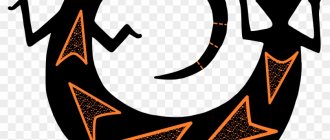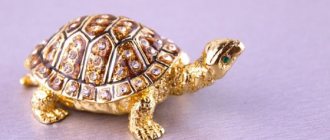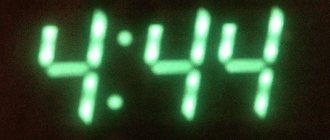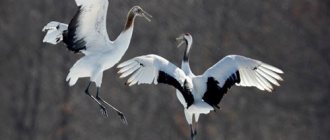| A long-wadied wading bird, the symbolic meaning of which is influenced by its long beak, tirelessness in flight (long-distance seasonal flights), organization of the flock, and caution (the bird's eyes have a 360-degree view). In ancient images it is often confusingly similar to a stork or a heron, from which it can be distinguished by its typical pose - with a stone raised with a stone clutched in its claws. This feature of the image goes back to legendary information, according to which, “every night the cranes gather around their king. Certain cranes are chosen as guardians, and they must stay awake all night, fighting off sleep with all their might. Therefore, each guardian crane stands on one leg, raising the other. He holds a stone in his raised paw. If a crane falls asleep, a stone will fall out of its paw and, falling on the paw on which it stands, will wake it up.” Like other birds standing in the water (ibis, stork, heron), the crane is one of the embodiments of the light of the morning sun, since it is the first to see its rise. As an intermediary between worlds, the crane acts as a messenger from God and a conductor (carrier) of the souls of the dead to the place of their afterlife. Thanks to its long beak and mating dances, the crane in many traditions acts as a phallic symbol, as well as a messenger of fertility, bringing rain. Mediterranean cultures are characterized by the erotic “crane dance”. The use of the crane as an allegory of justice, longevity, righteousness and a merciful soul is very widespread (from Mediterranean cultures to China). The crane also attracts attention as a snake fighter. Basic values:
|
Content
- 1 Basic values:
- 2 Egypt
- 3 Antiquity
- 4 Northern tradition
- 5 China
- 6 Japan
- 7 Indochina
- 8 Hinduism
- 9 Buddhism
- 10 Bible/Old Testament
- 11 Christianity
- 12 Magic
- 13 Fortune telling
- 14 Heraldry
- 15 Emblems
- 16 Psychology
- 17 Art
- 18 ad vocem
- 19 Illustrations
- 20 Notes and comments
See also:
Birds Stork Heron Ibis Vigilance
Is it better to have a bird in your hands?
The proverb “Better a bird in the hand than a pie in the sky”, known to everyone since time immemorial, did not appear out of nowhere. The crane is a symbol of high aspirations and global goals. And as we know, fate gives strength to overcome obstacles only to those who set themselves truly difficult tasks. Who is not afraid to lose what little they have in order to achieve their dreams. If you are ready to let go of the titmouse and chase the crane, be sure to decorate one of the walls of your apartment with a poster of a flying crane or a crane wedge. The main thing is that the birds fly towards you, and not away from you!
Antiquity
For the ancient Greeks, the arrival of cranes and their screeching was a signal for the beginning of sowing, and then the harvest.
Attribute (dedicated):
- Apollo - like a bird of light, the messenger of spring.
- Hermes - as a tireless traveler (wanderer);
- Demeters;
- Artemis;
- Athens Pallas, Athens-Hera;
- Perseus.
The famous crane dance geranikos - the embodiment of cheerfulness and love, is based on the movement of cranes during the current and is associated with the cult of Athena-Hera[2]. Later it is reinterpreted as the dance of the Sun, and its occurrence is associated with the joyful dance of Theseus and his companions emerging from the Labyrinth. This explains the circular movements of the “crane” dancers around the altar decorated with horns, reproducing the curves of the Cretan Labyrinth or labyrinth where the initiation ceremony took place.
Persistent ancient themes associated with cranes include:
- the enmity of cranes with pygmies living in the south of Egypt and Ethiopia[3].
“The cranes, screeching so loudly, fly up into the endless sky, escaping the hardships of winter... On their wings they carry away ruin and death for the pygmies.” "Iliad" by Homer.
- cranes Ibicus (Ibicus) - a school of cranes became the only witness to the murder of the Greek poet and singer Ibicus (the killers gave themselves away when at the market one of them, looking at the sky, exclaimed: “Cranes of Ibicus!”).
- The crane's stinginess is a fable about a stingy owner, first found in Aesop's story about the crane and the fox.
Legends about the origin of the Greek alphabet are associated with the Crane Wedge. It is believed that the outline of a crane wedge flying in the sky served as the basis for drawing the letters with which Palamedes (according to another version - Hermes) supplemented the alphabet invented by King Cadmus. Thanks to this (?), the crane often acts as a companion (patron) of poets and serves as one of the symbols of dedication.
The meaning of the crane's position in feng shui
When the bird is depicted soaring in the clouds, it symbolizes wisdom and longevity. Most often, this picture is used by people who want to advance their careers.
The dancing crane symbolizes perseverance, prestige and righteousness. In pictures, this bird pose is often depicted among pine trees.
When depicted flying towards the sky, this spiritual meaning represents a wonderful afterlife. This is due to the fact that he is considered a guide of souls on the path to heaven. For this reason, cranes are sometimes seen during funeral processions in China.
People who are planning to fly by plane are sometimes given souvenirs with the image of a crane. This bird is associated with smooth flight and confidence. Such an amulet will protect a person in the air from harm.
China
Crane (ho, he) - “Patriarch of the Feathered Tribe”, messenger of the gods, mediator between heaven and earth, endowed with many positive properties and meanings. It is believed that from the inside this bird is absolute Yang, devoid of the principle of death.
Snow-white cranes are holy birds that inhabit the Isles of the Blessed. The color of their plumage serves as a symbol of purity, and the cinnabar-colored head is an indication that he knows how to retain vitality within himself. The Immortals of the Taoist tradition and the souls of the dead fly in the skies on cranes, heading to the Western Taoist paradise. The death of Taoist priests is described with the words "yu-hua", which suggests their transformation into cranes.
The black crane, according to popular belief, can live up to a thousand years, partly due to the ability to breathe with a bent neck; This technique, which softens the breath, is practiced by Taoists.
The bending neck of a crane is also considered a sign (symbol) of wisdom - offensive and vain words linger in its bends, giving time to think and prepare a balanced answer.
The crane often appears in fine art as an image of long life, most often as part of a "triple symbol of longevity" including crane, pine and stone. The latter can sometimes be replaced by cypress.
Together with the phoenix, heron, duck and wagtail, it is part of a group of birds representing five types of relationships between people - it embodies a model of the relationship between father and son (the crane chick responds to the cry of its parents).
The crane rising to the Sun expresses the desire for social advancement and serves as a symbol of prosperity and high official position.
Background about cranes according to Feng Shui
Many ancient legends tell about the wonderful properties of this sophisticated bird. For example, in ancient mythology, the crane was a companion of the god Apollo as a spring solar bird.
The crane became a companion to the god Hermes, the patron saint of travelers, because of its powerful wings that never tire.
figurine “pair of cranes”
In the service of the goddess Demeter, the crane is a companion - a harbinger of a rich harvest.
Among the ancient peoples of Europe and Asia, the arrival of cranes in their lands was considered a good sign, promising a bountiful harvest and favorable events in people's lives.
There is a myth that when Hermes invented the alphabet, he wrote the first 7 letters while watching the flight of a crane wedge.
In Eastern countries, especially in China and Japan, the crane has been revered and respected since ancient times. It is a symbol of health, longevity, wisdom, prosperity, high position, nobility and justice, and is also considered a talisman of good luck. A pair of cranes symbolizes strong marriage bonds and family happiness.
mating dances of cranes
The Chinese also believe that cranes accompany angels in the sky, as well as the souls of the dead, to the other world.
And the Japanese used to consider cranes “people in feathers”, they believed that cranes were capable of taking on a human form, being messengers of God on earth.
According to one Japanese legend, a person who makes a thousand cranes out of paper will gain health and long life.
The whole world remembers the story of the Hiroshima girl Sadako Sasaki, who survived the atomic bombing at the age of 4 and died at the age of 14 from radiation sickness. She began folding paper cranes with the hope of recovery, but only managed to make 643 figures. Sadako folded the last one, having already lost her sight. The remaining 1,357 cranes were folded by the children from the girl’s class.
Sadako became the prototype for a sculpture installed in the Peace Park in Hiroshima in memory of the child victims of the atomic bomb. A bronze figure of a girl holds the last crane, which she managed to make herself. To some extent, the belief about a long life in relation to Sadako was justified.
She died, but remained “to live in the memory” of millions of people. It has become a tradition according to which schoolchildren who come on excursions to Hiroshima must visit the Peace Park and come to the monument, leaving bundles of pre-prepared paper cranes with it.
Sadako Sasaki
In a word, the crane is a strong-winged, wise bird with many enviable qualities that have always been revered by people. Therefore, in Feng Shui, special attention is paid to it.
Emblematics
Sensitivity, observation. If something alarms the crane, it gives a signal by screaming or screeching; in order not to fall asleep, he stands on one leg and holds a stone in the toes of the other. This gave the bird a reputation as a stupid creature, a dullard.
“The crane at night prudently holds a pebble in its claws so as not to fall asleep by accident. So, when we trust the world too much and too easily, Time again reminds us of our righteous duty.” Hochberg.
Attribute:
- personified Vigilance - with a stone in its paw;
- ~ Melancholy - shot.
As a symbol of silence, it is depicted with a white cane in its beak.
A crane lifting a stone with its paw.
- It's hard to take me by surprise.
“Observations by naturalists have shown ... the crane, due to its fear of the unexpected, always sleeps with a stone in its paw so as not to fall too deeply asleep.”
EMSI 18-12, p.179 A crane with sand pouring out of its beak.
- Speak only at the appropriate time and in the appropriate place.
Symbol of silence: we must be careful what we say, where we say it, when we say it, and to whom we say it.
Another image of forethought attributed to the crane. “By filling its beak with sand and carelessly pouring it out, it makes noise and thereby gives itself away.” EMSI 18-13, p.179 Crane eating snakes.
- By pleasing my stomach, I benefit my country.
Symbol of patriotism.
“They say that there is an innate antipathy between cranes and snakes. Cranes find snake holes and eat their inhabitants, thereby clearing the area in which they live of snakes. In Egypt and Thessaly, where many snakes lived, killing a crane... was punishable by death. In addition, cranes are well tamed and value human company - they are accustomed to building their nests near his home. They claim, although this is not confirmed by facts, that they have a special love for countries with a republican system of government. They have many other very valuable qualities and are one of the rare examples of extraordinary filial love.” EMSI 55-4, p.338 Crane swallowing a snake.
- It's a shame I can't destroy them all.
The symbol of a kind, merciful person, focused on doing good deeds, and determined to do as many good deeds as he can.
EMSI 58-15, p.351 A crane holding a stone in its paw.
- Be vigilant.
A symbol of vigilance, especially for the clergy.
“It shows that the clergy should not indulge in idleness and excessive sleep. For he who has taken upon himself the high responsibilities of directing the lives of others must be very vigilant to ensure that he himself does not stray from the right path. ... we should all learn to be constantly on guard, since we are all, to some extent, guardians.” EMSI 29-4, p.223 Crane with a stone in its beak.
- Restrain yourself.
A symbol of prudent restraint. “Cranes keep a stone in their beaks so as not to make unnecessary noise and prevent themselves from being detected. In this way, cranes escaped from eagles in the area of Mount Taurus.” EMSI 29-2, p.223
To strengthen marital bonds
The crane, like the popular mandarin ducks, is a symbol of marriage and romance. These birds are monogamous and live with one partner all their lives. Therefore, the crane is associated with harmony and peace in the family.
Although the bird will probably not bring romantic luck in love, like the mandarin duck, it helps strengthen family ties and procreation. Therefore, crowned white cranes with red crowns are a suitable gift for the head of the family, for example, for an anniversary and birthday.
The meaning of tattoos for girls
A crane tattoo is suitable for a modest girl and will emphasize her purity and flexible character. The owner of such a tattoo dreams of a happy family and a home. She has strong ties to her parents. Such a girl is responsive and ready to help. The crane tattoo speaks of her gentle and romantic nature and sensitive soul. Such girls become devoted and faithful wives.
The meaning of tattoos for men
For guys, a crane tattoo symbolizes determination and courage, fearlessness and courage, courage and will. The wingspan speaks of the breadth of life views of the owner of the tattoo.
The image of a bird can be seen in a simple-minded and open-minded man. He is kind and sympathetic and is always ready to help and protect his loved ones. Such a man looks at life philosophically. Family values mean a lot to him. He is a support for his family.











